Quasi-Static Rheological Properties of Lithium-Based Magnetorheological Grease under Large Deformation
Abstract
:1. Introduction
2. Experimental Testing
2.1. MR Grease Preparation
2.2. Quasi-Static Test of MR Grease
3. Result and Discussion
3.1. Rheology in Quasi-Static Monotonic Shear
3.1.1. Quasi-Static Monotonic Shear for MR Grease with Different CI Particles Content
3.1.2. Quasi-Static Monotonic Shear for MR Grease under Different Shear Rate
3.1.3. Quasi-Static Monotonic Shear for MR Grease under Different Temperature
3.2. Rheology in Quasi-Static Cyclic Shear
3.2.1. Quasi-Static Cyclic Shear for MR Grease with Different CI Particles Content
3.2.2. Quasi-Static Cyclic Shear for MR Grease with Different Shear Rate
3.2.3. Quasi-Static Cyclic Shear for MR Grease with Different Shear Strain
3.2.4. Quasi-Static Cyclic Shear for MR Grease under Multiple Cyclic Loading
4. Conclusions
Author Contributions
Funding
Acknowledgments
Conflicts of Interest
References
- Ashour, O.; Rogers, C.A.; Kordonsky, W. Magnetorheological fluids: Materials, characterization, and devices. J. Intell. Mater. Syst. Struct. 1996, 7, 123–130. [Google Scholar] [CrossRef]
- Shah, K.; Seong, M.-S.; Upadhyay, R.; Choi, S.-B. A low sedimentation magnetorheological fluid based on plate-like iron particles, and verification using a damper test. Smart Mater. Struct. 2013, 23, 027001. [Google Scholar] [CrossRef]
- Ginder, J.; Davis, L.; Elie, L. Rheology of magnetorheological fluids: Models and measurements. Int. J. Mod. Phys. B 1996, 10, 3293–3303. [Google Scholar] [CrossRef]
- Liao, G.; Gong, X.; Xuan, S. Structures. Phase based stiffness tuning algorithm for a magnetorheological elastomer dynamic vibration absorber. Smart Mater. Struct. 2013, 23, 015016. [Google Scholar] [CrossRef]
- Yu, M.; Wang, S. The composite MRE embedded with a copper coil. Smart Mater. Struct. 2010, 19, 065023. [Google Scholar] [CrossRef]
- Ginder, J.; Clark, S.; Schlotter, W. Magnetostrictive phenomena in magnetorheological elastomers. Int. J. Mod. Phys. B 2002, 16, 2412–2418. [Google Scholar] [CrossRef]
- Kavlicoglu, B.M.; Gordaninejad, F.; Evrensel, C.A.; Cobanoglu, N.; Liu, Y.; Fuchs, A.; Korol, G. High-torque magnetorheological fluid clutch. In Smart Structures and Materials 2002: Damping and Isolation; Agnes, G.S., Ed.; International Society for Optics and Photonics: Bellingham, WA, USA, 2002; pp. 393–401. [Google Scholar]
- Ngatu, G.T.; Wereley, N.M. Viscometric and sedimentation characterization of bidisperse magnetorheological fluids. IEEE Trans. Magn. 2007, 43, 2474–2476. [Google Scholar] [CrossRef]
- Mohamad, N.; Mazlan, S.A.; Ubaidillah, C.S.-B.; Imaduddin, F.; Abdul Aziz, S.A. The field-dependent viscoelastic and transient responses of plate-like carbonyl iron particle based magnetorheological greases. J. Intell. Mater. Syst. Struct. 2019. [Google Scholar] [CrossRef]
- Wang, H.X.; Li, Y.C.; Zhang, G.; Wang, J. Effect of temperature on rheological properties of lithium-based magnetorheological grease. Smart Mater. Struct. 2019, 28. [Google Scholar] [CrossRef]
- Changsheng, Z. Experimental investigation on the dynamic behavior of a disk-type damper based on magnetorheological grease. J. Intell. Mater. Syst. Struct. 2006, 17, 793–799. [Google Scholar] [CrossRef]
- Sugiyama, S.; Sakurai, T.; Morishita, S. Vibration control of a structure using Magneto-Rheological grease damper. Front. Mech. Eng. 2013, 8, 261–267. [Google Scholar] [CrossRef]
- Kavlicoglu, B.M.; Gordaninejad, F.; Wang, X. Study of a magnetorheological grease clutch. Smart Mater. Struct. 2013, 22, 125030. [Google Scholar] [CrossRef]
- Takesue, N.; Asaoka, H.; Lin, J.; Sakaguchi, M.; Zhang, G.; Furusho, J. Development and experiments of actuator using MR fluid. In Proceedings of the 26th Annual Conference of the IEEE Industrial Electronics Society 2000, Nagoya, Japan, 22–28 October 2000; pp. 1838–1843. [Google Scholar]
- Choi, Y.-T.; Wereley, N.M.; Jeon, Y.-S. Semi-active vibration isolation using magnetorheological isolators. J. Aircr. 2005, 42, 1244–1251. [Google Scholar] [CrossRef]
- Rankin, P.J.; Horvath, A.T.; Klingenberg, D.J. Magnetorheology in viscoplastic media. Rheol. Acta 1999, 38, 471–477. [Google Scholar] [CrossRef]
- Sahin, H.; Gordaninejad, F.; Wang, X. Rheological behavior of magneto-rheological grease (MRG). In Active and Passive Smart Structures and Integrated Systems 2007; Matsuzaki, Y., Ahmadian, M., Donald, J.L., Eds.; Society of Photo Optical: Bellingham, WA, USA, 2007. [Google Scholar]
- Sahin, H.; Wang, X.; Gordaninejad, F. Temperature Dependence of Magneto-rheological Materials. J. Intell. Mater. Syst. Struct. 2009, 20, 2215–2222. [Google Scholar] [CrossRef]
- Park, B.O.; Park, B.J.; Hato, M.J.; Choi, H.J. Soft magnetic carbonyl iron microsphere dispersed in grease and its rheological characteristics under magnetic field. Colloid Polym. Sci. 2011, 289, 381–386. [Google Scholar] [CrossRef]
- Mohamad, N.; Mazlan, S.A.; Ubaidillah, C.S.-B.; Nordin, M.F.M. The Field-Dependent Rheological Properties of Magnetorheological Grease Based on Carbonyl-Iron-Particles. Smart Mater. Struct. 2016, 25, 10. [Google Scholar] [CrossRef]
- Sahasrabudhe, S.S.; Nagarajaiah, S. Semi-active control of sliding isolated bridges using MR dampers: An experimental and numerical study. Earthq. Eng. Struct. Dyn. 2005, 34, 965–983. [Google Scholar] [CrossRef]
- Guo, A.; Li, Z.; Li, H.; Ou, J. Experimental and analytical study on pounding reduction of base-isolated highway bridges using MR dampers. Earthq. Eng. Struct. Dyn. 2009, 38, 1307–1333. [Google Scholar] [CrossRef]
- Kim, Y.; Langari, R.; Hurlebaus, S. Semiactive nonlinear control of a building with a magnetorheological damper system. Mech. Syst. Sig. Proc. 2009, 23, 300–315. [Google Scholar] [CrossRef]
- Bharti, S.; Dumne, S.; Shrimali, M. Seismic response analysis of adjacent buildings connected with MR dampers. Eng. Struct. 2010, 32, 2122–2133. [Google Scholar] [CrossRef]
- Liu, T.; Gong, X.; Xu, Y.; Pang, H.; Xuan, S. Magneto-induced large deformation and high-damping performance of a magnetorheological plastomer. Smart Mater. Struct. 2014, 23, 105028. [Google Scholar] [CrossRef]
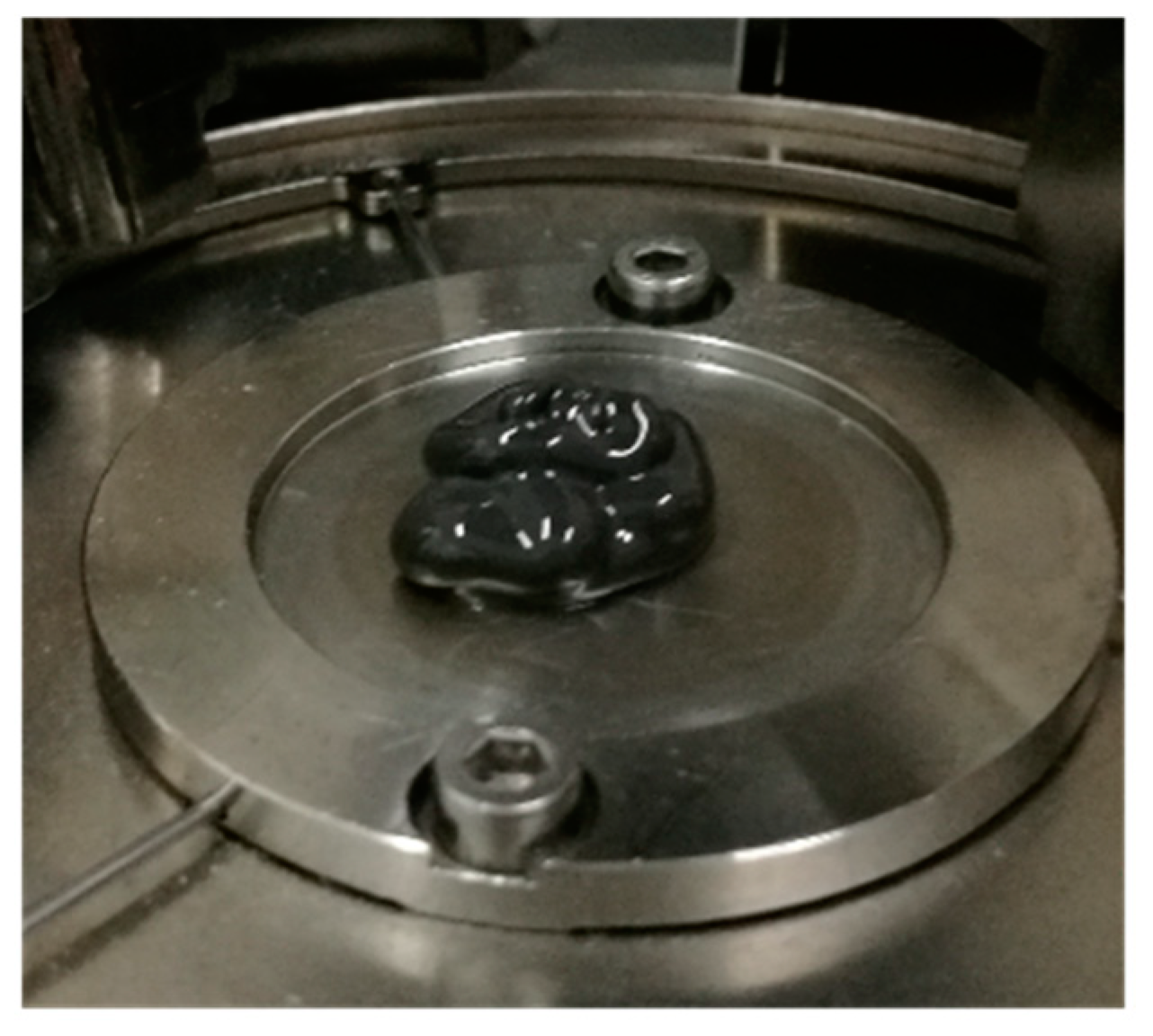
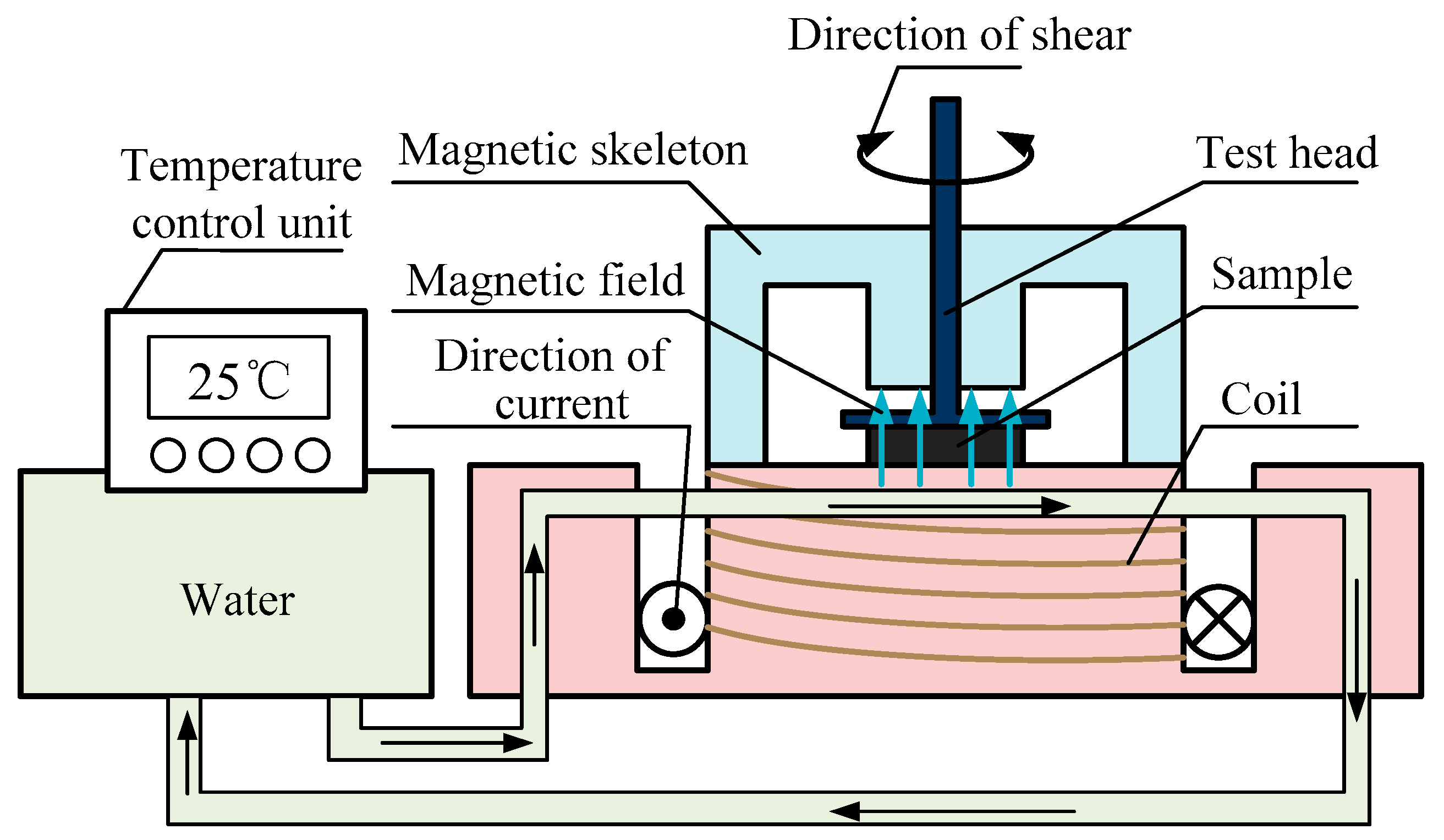
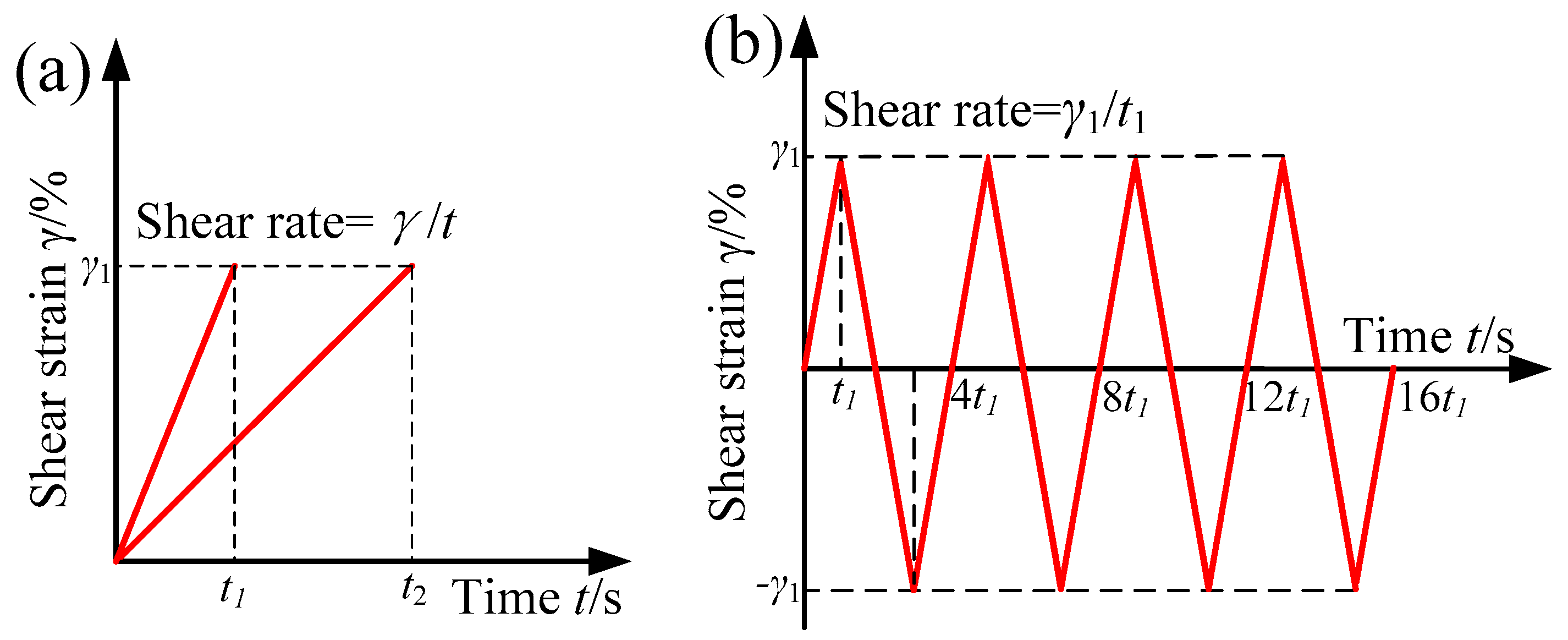
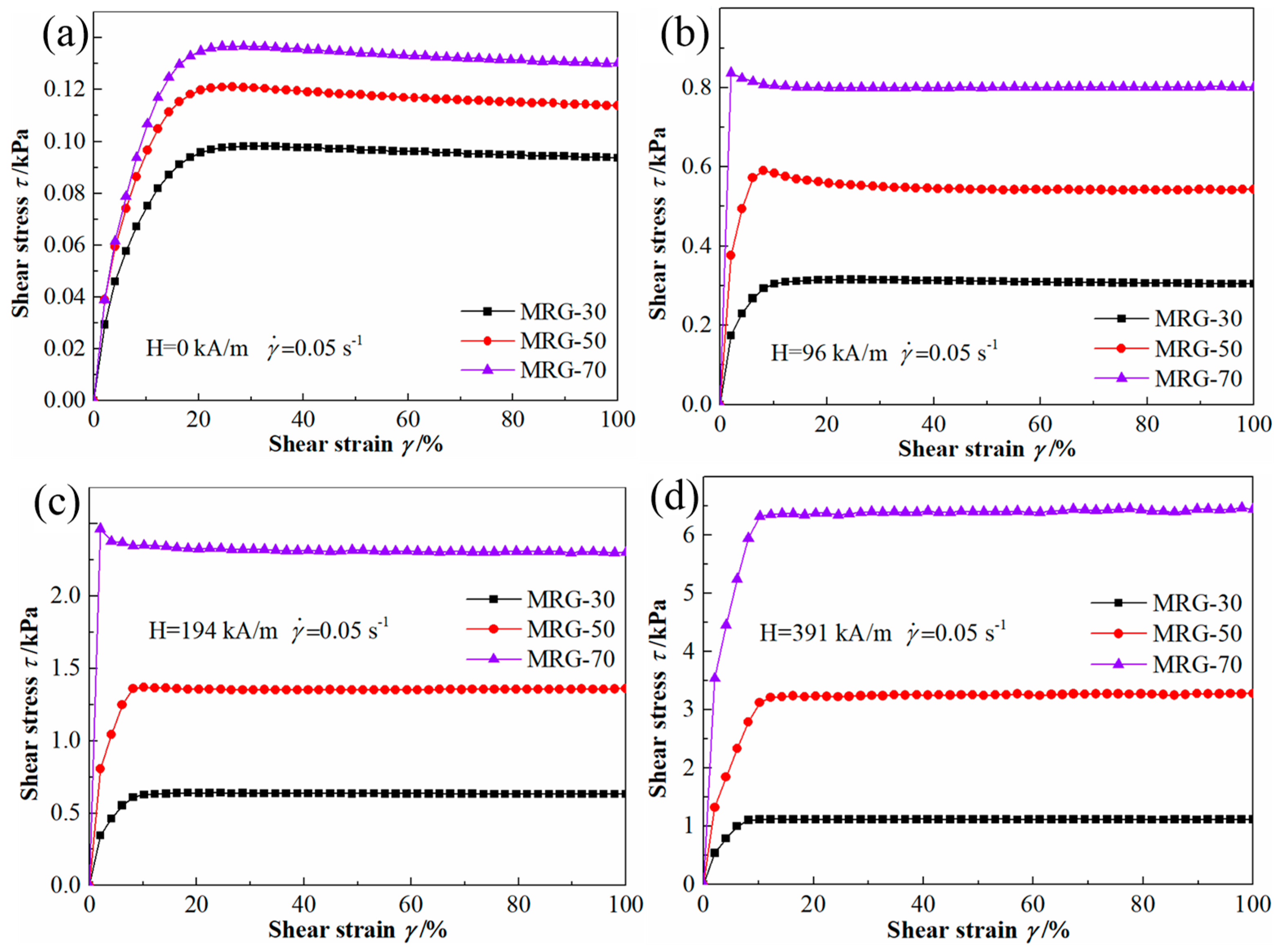
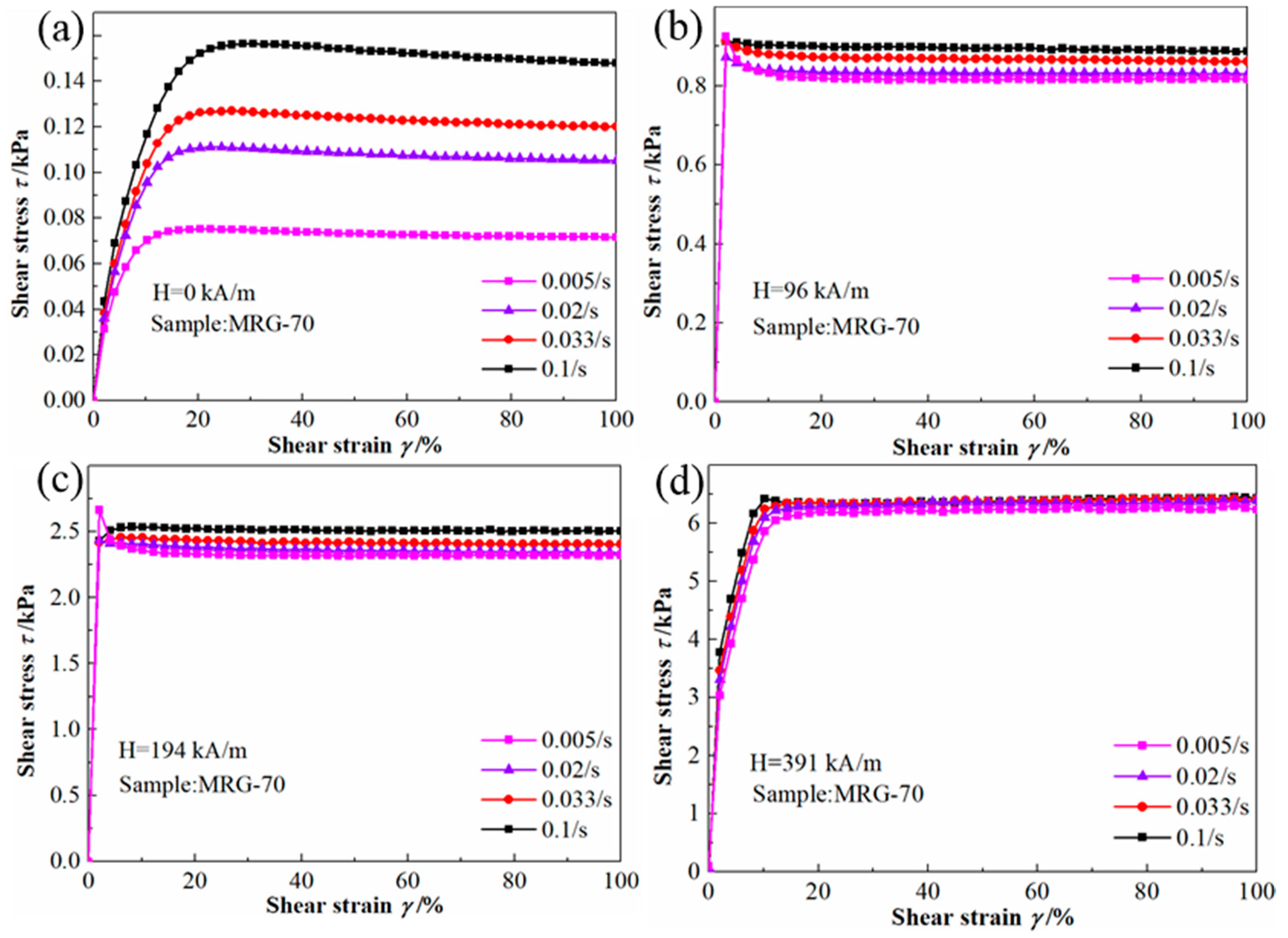

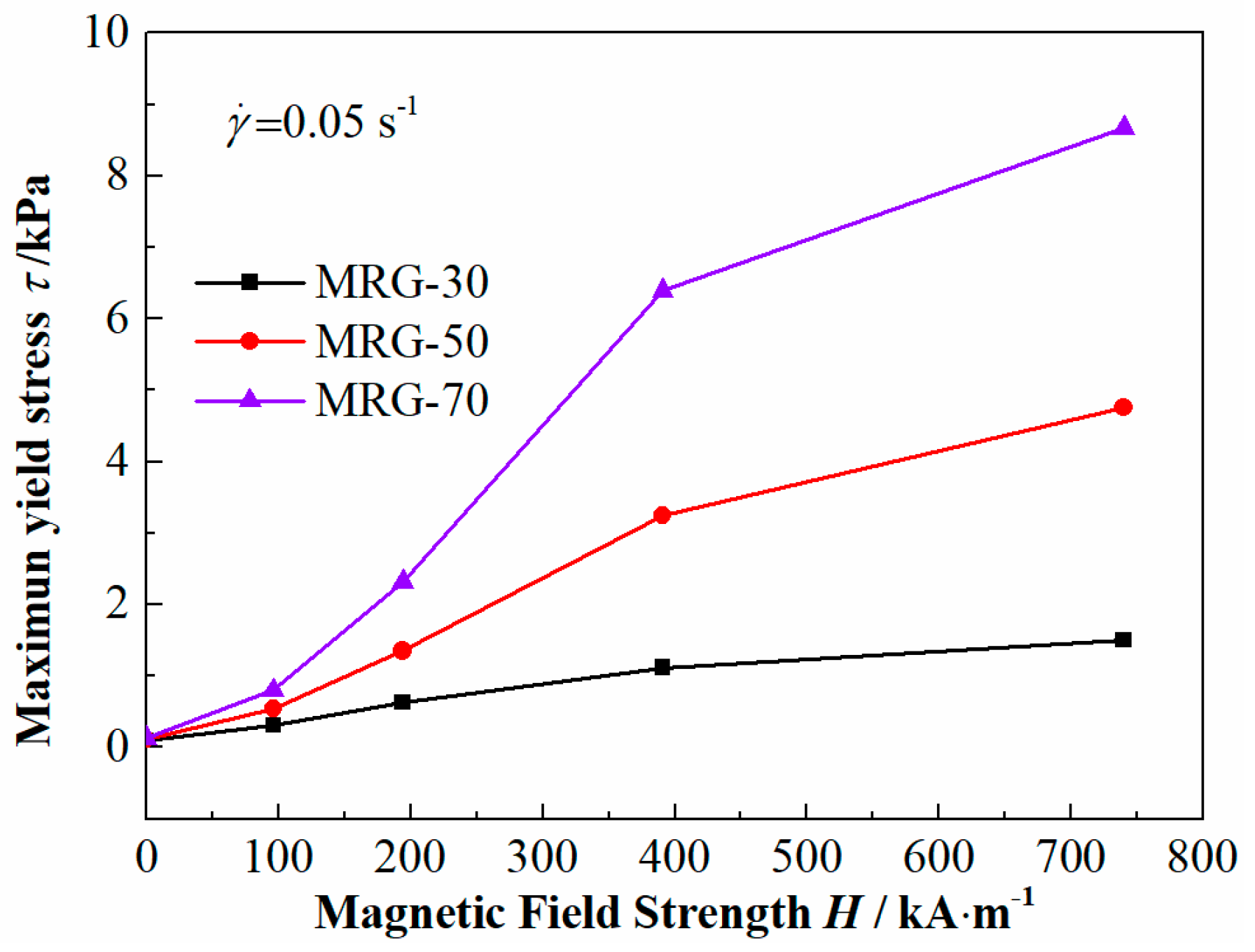

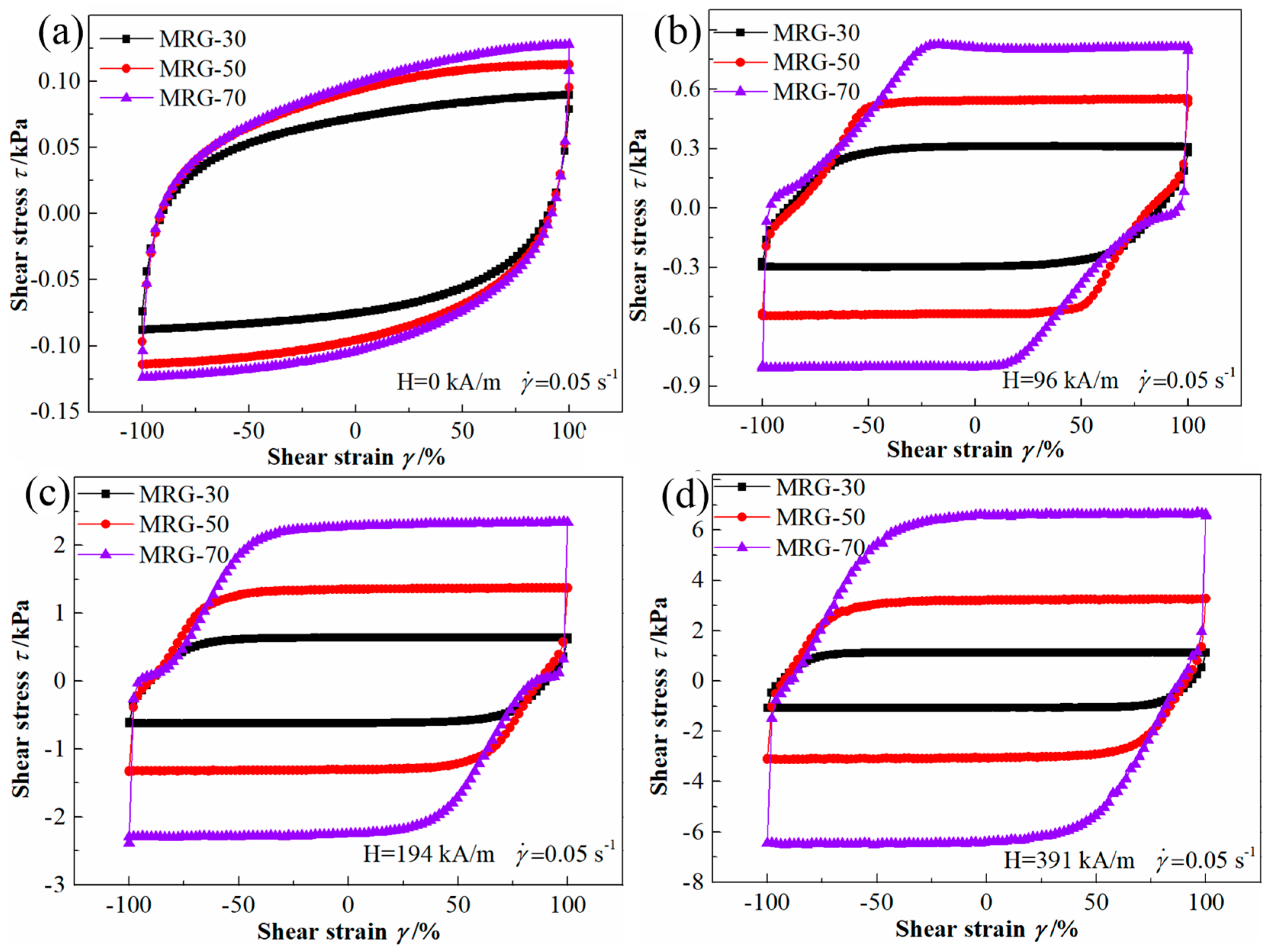
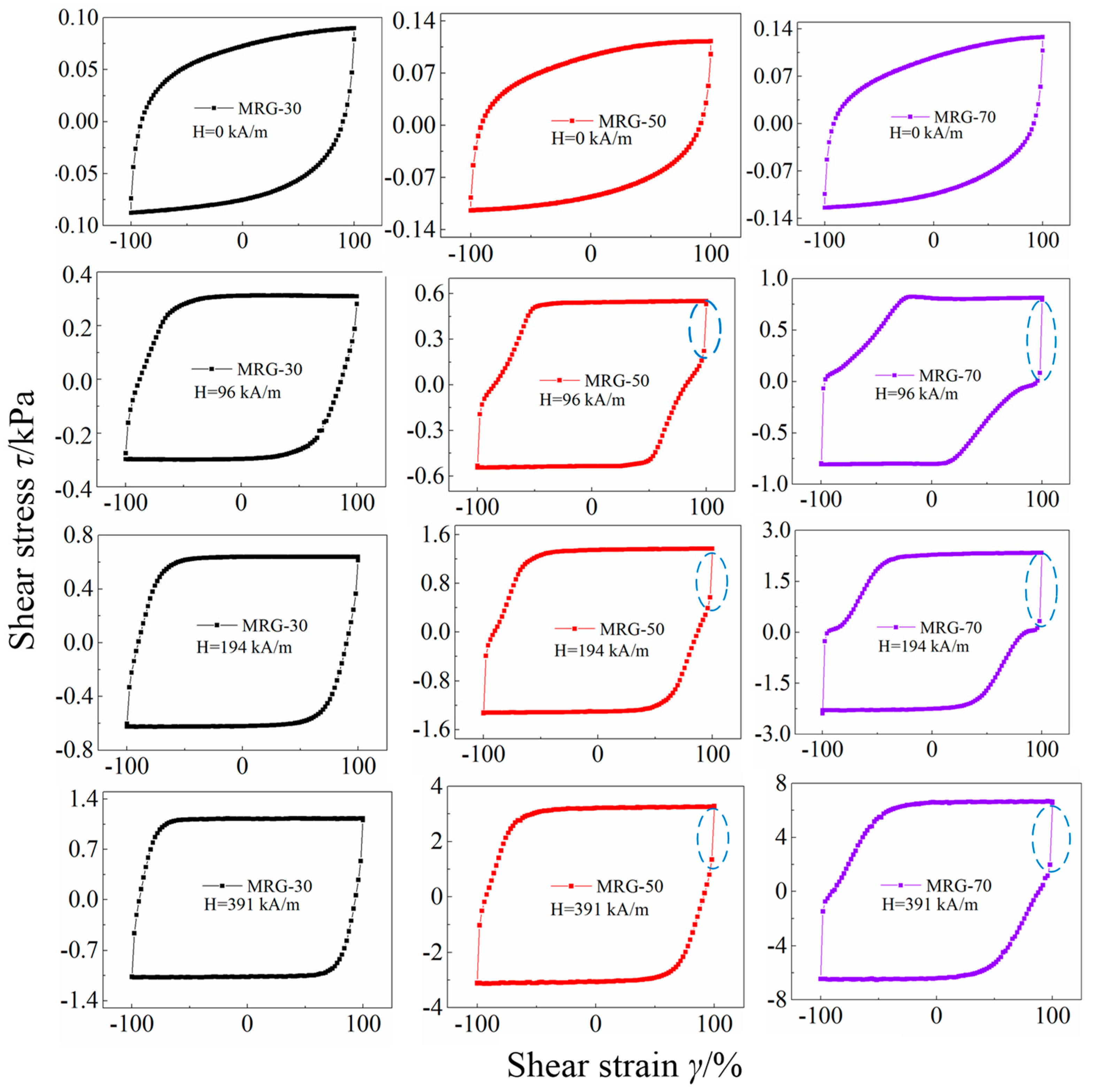
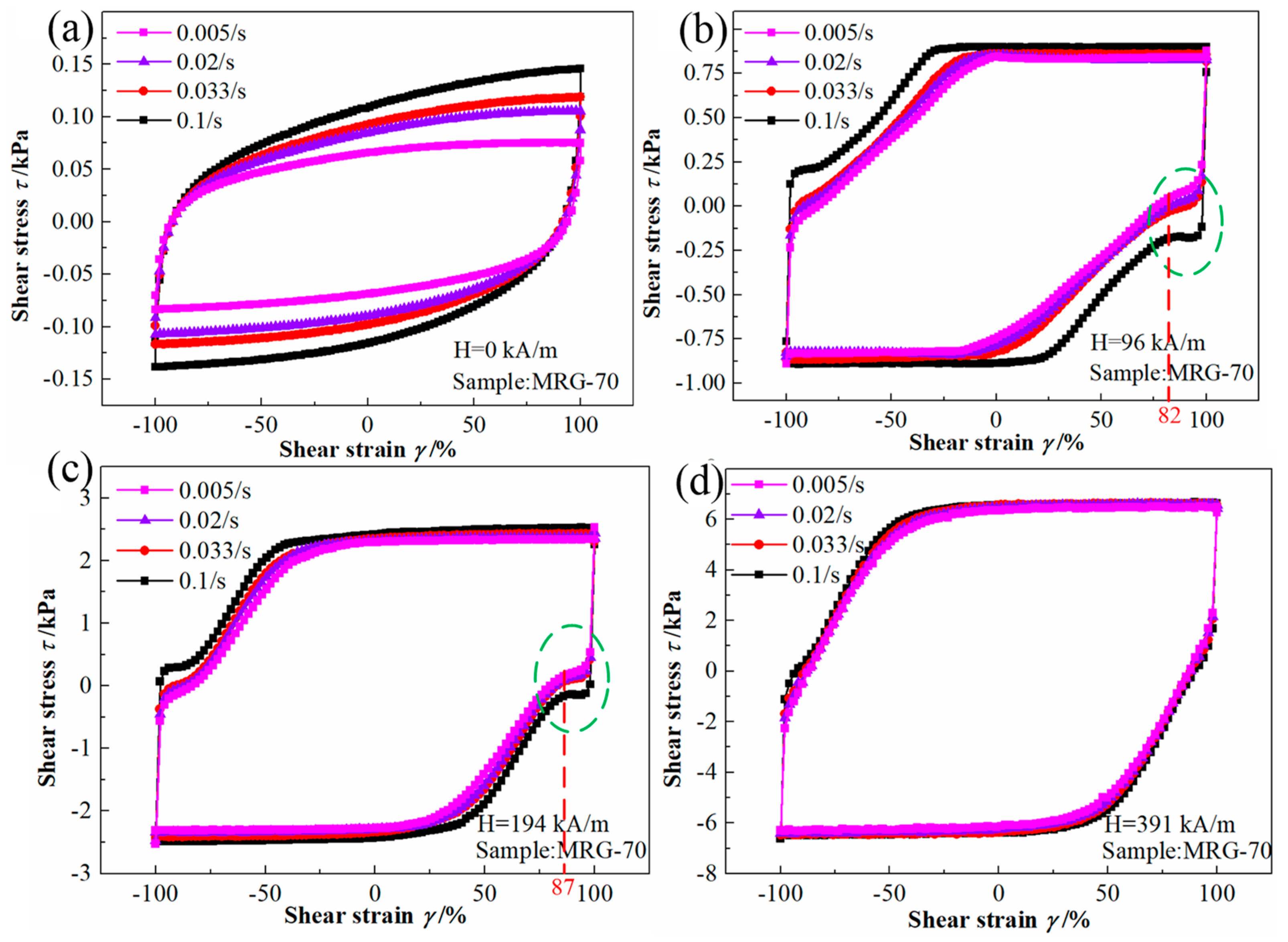

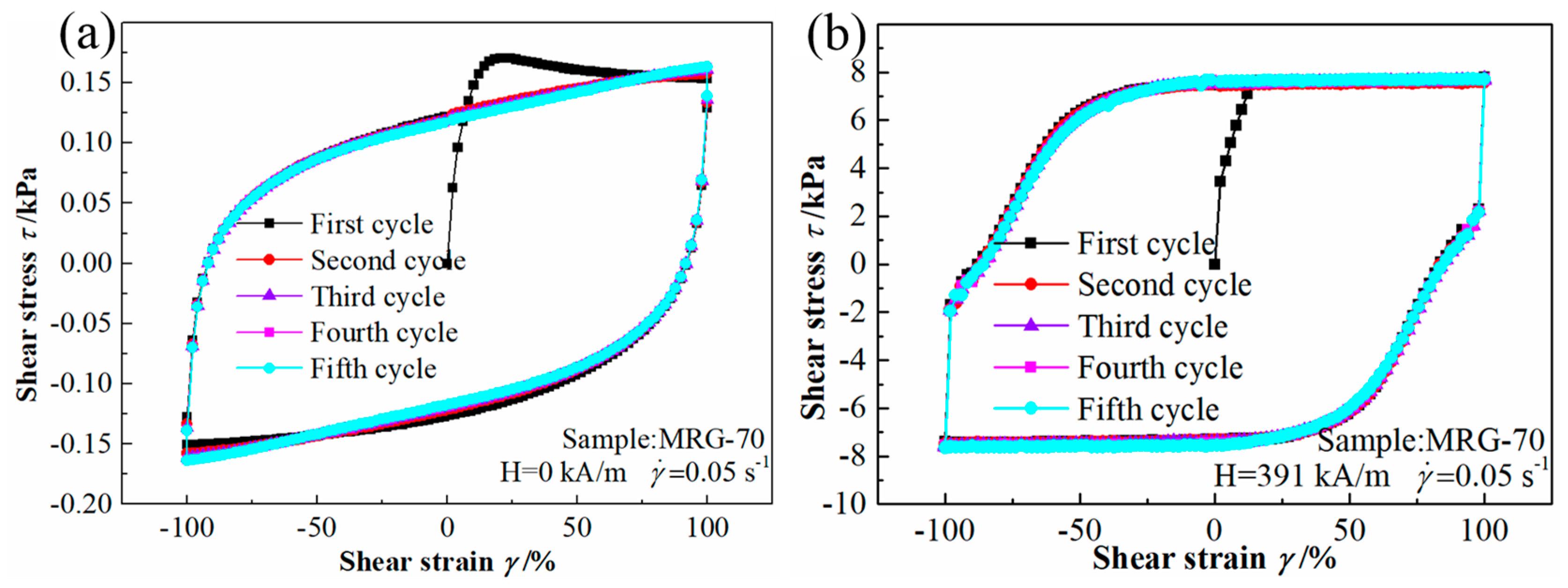
| Samples | CI Particles | Lithium-based Grease |
|---|---|---|
| MRG-30 | 30 | 70 |
| MRG-50 | 50 | 50 |
| MRG-70 | 70 | 30 |
| Samples | Magnetic Field Strength | Shear Stress τ (Pa) | Shear Stress Increase (τ0.1/s − τ0.005/s)/τ0.005/s × 100% | |
|---|---|---|---|---|
| Shear Rate | ||||
| 0.005/s | 0.1/s | |||
| MRG-30 | 0 kA/m | 29.6 | 101 | 241% |
| 391 kA/m | 1060 | 1150.6 | 8.6% | |
| MRG-50 | 0 kA/m | 68.4 | 133.5 | 95.2% |
| 391 kA/m | 3128.1 | 3306.3 | 5.7% | |
| MRG-70 | 0 kA/m | 73.2 | 153.5 | 110% |
| 391 kA/m | 6232.6 | 6389.5 | 2.5% | |
| Magnetic Field Strength | Loop Area D (KJ/m3) | Particles Content-Induced Effect (DMRG-70 − DMRG-30)/DMRG-30 × 100% | ||
|---|---|---|---|---|
| Sample Type | ||||
| MRG-30 | MRG-50 | MRG-70 | ||
| 0 kA/m | 0.26 | 0.33 | 0.36 | 38.5% |
| 96 kA/m | 1 | 1.75 | 2.46 | 146% |
| 194 kA/m | 2.17 | 4.49 | 7.3 | 236% |
| 391 kA/m | 3.96 | 10.91 | 20.89 | 428% |
| Magneto-induced effect (D391kA/m − D0kA/m)/D0kA/m × 100% | 1423% | 3206% | 5703% | - |
| MR Grease Type | Shear Stress Change Rate | ||
|---|---|---|---|
| Magnetic Field Strength | |||
| 96 kA/m | 194 kA/m | 391 kA/m | |
| MRG-50 | 59.6% | 58.1% | 58.7% |
| MRG-70 | 89.8% | 85.9% | 70.3% |
| Magnetic Field Strength | Loop Area D (KJ/m3) | Shear Rate-Induced Effect (D0.1/s − D0.005/s)/D0.005/s × 100% | |||
|---|---|---|---|---|---|
| Shear Rate | |||||
| 0.005/s | 0.02/s | 0.033/s | 0.1/s | ||
| 0 kA/m | 0.23 | 0.31 | 0.34 | 0.41 | 78.3% |
| 96 kA/m | 2.29 | 2.39 | 2.5 | 2.85 | 24.5% |
| 194 kA/m | 7.01 | 7.25 | 7.45 | 7.96 | 13.6% |
| 391 kA/m | 19.85 | 20.33 | 20.67 | 21.16 | 6.6% |
| Magneto-induced effect (D391 kA/m − D0 kA/m)/D0 kA/m × 100% | 8530% | 6458% | 5979% | 5061% | - |
| Magnetic Field Strength | Loop Area D (KJ/m3) | Shear Strain-Induced effect (D100% − D20%)/D20% × 100% | ||||
|---|---|---|---|---|---|---|
| Shear Strain Amplitude | ||||||
| 20% | 40% | 60% | 80% | 100% | ||
| 0 kA/m | 0.03 | 0.11 | 0.2 | 0.29 | 0.38 | 1167% |
| 96 kA/m | 0.67 | 1.15 | 1.51 | 1.94 | 2.46 | 267% |
| 194 kA/m | 1.11 | 2.59 | 3.97 | 5.48 | 7.12 | 541% |
| 391 kA/m | 3.21 | 7.32 | 11.42 | 15.94 | 20.75 | 546% |
| Magneto-induced effect (D391 kA/m − D0 kA/m)/D0 kA/m × 100% | 10,600% | 6556% | 5610% | 5397% | 5360% | - |
© 2019 by the authors. Licensee MDPI, Basel, Switzerland. This article is an open access article distributed under the terms and conditions of the Creative Commons Attribution (CC BY) license (http://creativecommons.org/licenses/by/4.0/).
Share and Cite
Wang, H.; Zhang, G.; Wang, J. Quasi-Static Rheological Properties of Lithium-Based Magnetorheological Grease under Large Deformation. Materials 2019, 12, 2431. https://doi.org/10.3390/ma12152431
Wang H, Zhang G, Wang J. Quasi-Static Rheological Properties of Lithium-Based Magnetorheological Grease under Large Deformation. Materials. 2019; 12(15):2431. https://doi.org/10.3390/ma12152431
Chicago/Turabian StyleWang, Huixing, Guang Zhang, and Jiong Wang. 2019. "Quasi-Static Rheological Properties of Lithium-Based Magnetorheological Grease under Large Deformation" Materials 12, no. 15: 2431. https://doi.org/10.3390/ma12152431
APA StyleWang, H., Zhang, G., & Wang, J. (2019). Quasi-Static Rheological Properties of Lithium-Based Magnetorheological Grease under Large Deformation. Materials, 12(15), 2431. https://doi.org/10.3390/ma12152431






